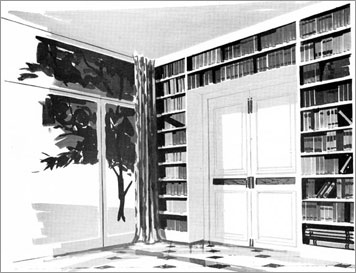
65 Ways to Decorate with Books in Your Home, 1956, illustrator unknown
When ink on paper finally goes the way of the Dodo (or the eight track), as certain dodos have predicted, heaps of printed papers will remain on earth. So the question will be what to do with what's left? Ray Bradbury suggests in his 1953 dystopian science-fiction novel, Fahrenheit 451, that incineration is an option, but in truth the looming paper redundancy does not demand such hot draconian measures. When every bit of recorded human knowledge is digitized and available through Google or Jeeves alternative uses must be found for untold metric tons of paper, and particularly all those pesky books. So what is needed is the repurposing of these venerable materials into useful life-enhancing goods. Any suggestions?
Even before the advent of the digital information revolution, books were overshadowed by the specter of forced obsolescence. What does one do after reading the latest bestseller? Give or throw it away? Ultimately, books (read or not) end up on someone's shelf somewhere, perhaps never to be handled again (other than to periodically dust them), which is reason enough to find new ways to imaginatively reuse them. So back in 1956, The New York Times promotion department provided a viable answer in the form of its The New York Times Shows You 65 Ways to Decorate with Books in Your Home, a book/zine with a reasonable $1 cover price. (I recently uncovered this lost document when the Times moved to its new headquarters.)
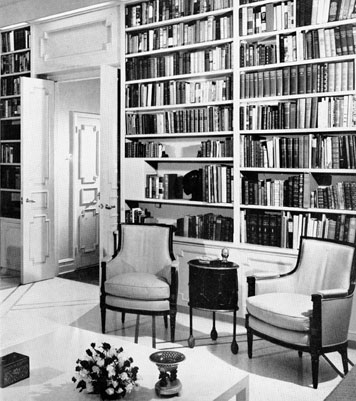
65 Ways to Decorate with Books in Your Home, 1956, photographer unknown
"There was a time, not so very long ago," wrote Betty Pepis, author of interior decoration books, in the introduction to 65 Ways to Decorate, "when books had little to do with the decorating of a home. Banished from the front parlor or the formal living room, they were confined to a den or a library reserved for the purpose... But homes have changed a great deal in the past two decades. Space is tighter. The front parlor is often the only parlor... So it has happened that books, of necessity, have become an inevitable part of the contemporary all-purpose living room... Integrating the library pleasantly into the home décor is a challenge that architects, designers and decorators have had to solve."
Indeed, in those heady golden days before most new-fangled apartment kitchens became stand-alone islands in living rooms, bedrooms were considerably larger than walk-in closets, and den/libraries were not called "home offices," books were ghettoized in their own "serious kind of place." The average apartment in 1956 was no longer spacious, and as Pepis rightly noted, designers were forced to view books as necessary components of their overall design schemes — if only to find ways to fit them into the home. Although covers and jackets were never originally designed to dress up an environment "recognizing that vividly colored bindings of the modern book can be utilized effectively as a positive decorating asset" had become a territorial imperative. Hats off to modernity.
"Books today are well dressed," added Pepis. "Gone, fortunately are the gloomy dull-covered tomes of earlier times [the ones that now command high prices on Ebay], forbidding and heavy in appearance." In their place, friendly brightly-colored covers and jackets often with ornamental motifs on the spines made an "effective and pretty picture when used to decorate a whole wall."
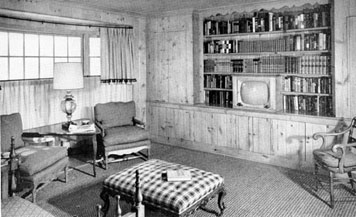
65 Ways to Decorate with Books in Your Home, 1956, photographer unknown
Separate libraries (a luxury in most average homes) gave way to the idea of bringing books as ornamental fixtures "out into the open" and this has, as Pepis proclaimed, "created new respect for their existence — books share shelf space with the most precious works and objects of art — in recognition of the fact that all these moments of living collectively produce the individual personality of a room by reflecting the interest of its inhabitants." Furthermore, since the basic form of the book had not changed in hundreds of years, most quotidian books exude a sense of timelessness that works just as well in Victorian, Art Deco or ultra Modern environments, and with Danish Modern, Nouveau Siamese or English Country furniture. Here, for example, is how the reader was told that books add dimension to the modernistic home of a famous art collector: "The asymmetric placement [of the books] enhances the owner's Dufy water color and provides space of other objects." And the chapter "Tie in With Traditional Formal Décor" addresses how, "French provincial pine paneling... frames books in a formal authentic period living room."
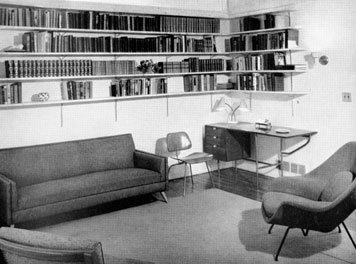
65 Ways to Decorate with Books in Your Home, 1956, photographer unknown
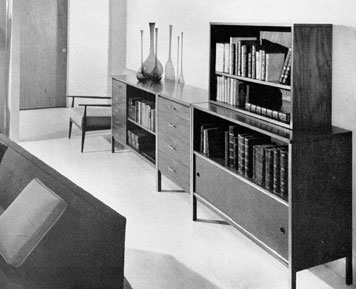
65 Ways to Decorate with Books in Your Home, 1956, photographer unknown
Incidentally, if you think that book décor is the last resort of mediocre designers, think again. In 65 Ways to Decorate, examples of bookdecor include rooms designed by Eliot Noyes, George Nelson, Philip Johnson, Gio Ponti, Henriette Granville and Melanie Kahane (married to pioneer news anchor and typophile, Ben Grauer).
Once these and other respected designers liberated books from being mere vessels of words into what Pepis calls "respected objects of design," they also found that books provided functionality that the original scribes and printers could never have dreamed. In addition to chapters in 65 Ways to Decorate on specific decorative applications, including "Capitalize on Corners," "Be intelligent in Foyers," "Seasonal Supplements for Patios" and "Reading Matters in the Bedroom," books proved to be excellent sound and heat insulation, supports for tables and breakfronts, as well as pedestals, doorstops and other household accruements (though never as coasters).
If the past (51 years to be exact) foretells the future, there is hope on the horizon for books. Just as Ray Bradbury's "firemen" in Fahrenheit 451 were the ones who incinerated books, maybe "book designer" will be a synonym for an interior decorator who uses books to enhance the environment. Such, I suspect, is the essence of today's multiplatform design integration.
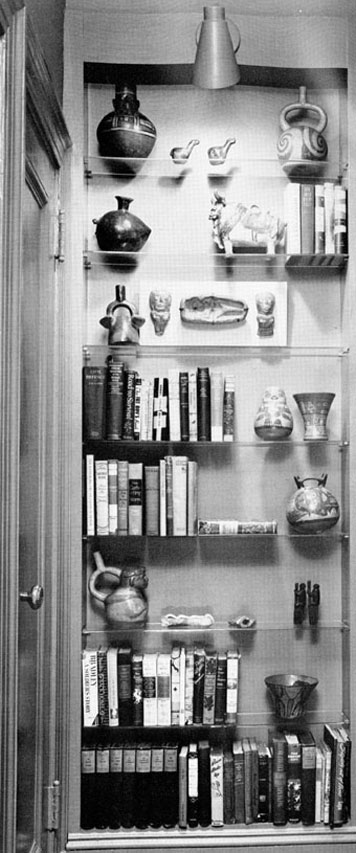
65 Ways to Decorate with Books in Your Home, 1956, photographer unknown
